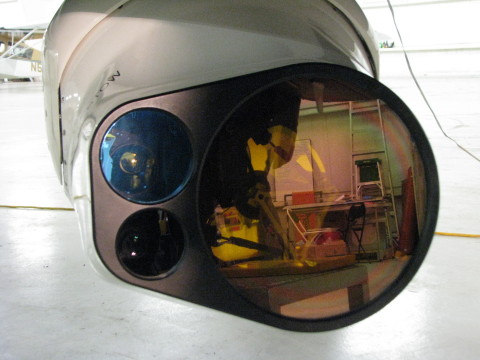ROCHESTER, N.Y.--(BUSINESS WIRE)--Exelis (NYSE: XLS) has successfully flight tested a long-wave infrared (LWIR) hyperspectral (HSI) sensor capable of pointing in multiple directions to identify threatening substances and gases.
The integrated sensor and processing system provides real-time information about the composition of gases and solids, which is critical in the detection of improvised explosive devices or leaks emanating from containers and pipeline used in a variety of industries from oil and gas to chemical manufacturing and nuclear power, among others.
“Customers are looking for reliable ways to locate and identify either naturally existing or man-made materials, some of which can be dangerous, illegal or items of interest that are not visible to traditional imaging cameras,” said Dr. Minda Suchan, director of material identification at Exelis. “Using a LWIR HSI sensor would allow access to hard-to-reach areas and positively identify solids and gases critical to defense, civilian and commercial operations.”
LWIR sensors must be cooled using a cryocooler to temperatures significantly below zero degrees Fahrenheit. At these temperatures the sensor is sensitive enough to detect and identify small amounts of gas released into the atmosphere as well as solid materials on the ground.
“We were able to overcome significant cooling requirements to ensure the sensor could collect usable data,” Suchan said. “This opens up new uses for LWIR HSI systems, such as looking into denied areas, from high-altitude aircraft. The LWIR HSI sensor development, along with real-time analytical processing, solves customer-identified hard problems and is a key part of the company’s strategic focus on intelligence, surveillance, reconnaissance and analytics.”
Most HSI sensors are mounted to aircraft such that the platform is required to fly directly over a target to collect imagery. With a system housed in a gimbal that can be pointed in multiple directions, the sensor can collect larger areas of imagery pointing both directly down to the ground and across the horizon. Also, with an on-board processing capability under development by Exelis, the system is suitable for mid-size to large manned and unmanned systems and provides a material identification system unavailable elsewhere to enable the fast collection of data without users being put into harm’s way.
For the flight test, the Exelis team staged various substances and materials around the Rochester area to test the sensor’s collection capabilities. After successful collection, the data were recorded and stored for processing later to ensure the materials could be properly identified. During a regular flight operation, the material would be processed immediately on board the aircraft, speeding up the time for the information to be used by customers.
More flights are planned in Rochester for additional testing.
About Exelis
Exelis is a diversified, top-tier global aerospace, defense, information and services company that leverages a 50-year legacy of deep customer knowledge and technical expertise to deliver affordable, mission-critical solutions for global customers. We are a leader in positioning and navigation, sensors, air traffic management solutions, image processing and distribution, communications and information systems; and focused on strategic growth in the areas of critical networks, ISR and analytics, electronic warfare and composite aerostructures. Headquartered in McLean, Va., Exelis employs about 17,000 people and generated 2013 sales of $4.8 billion. For more information, visit our website at www.exelisinc.com or connect with us on Facebook, Twitter and YouTube.




